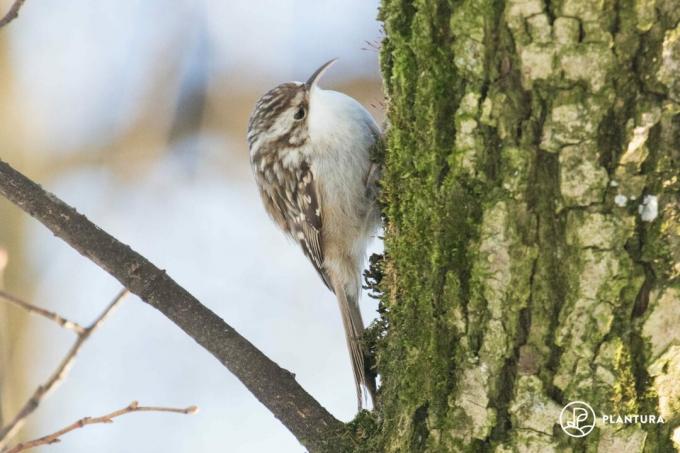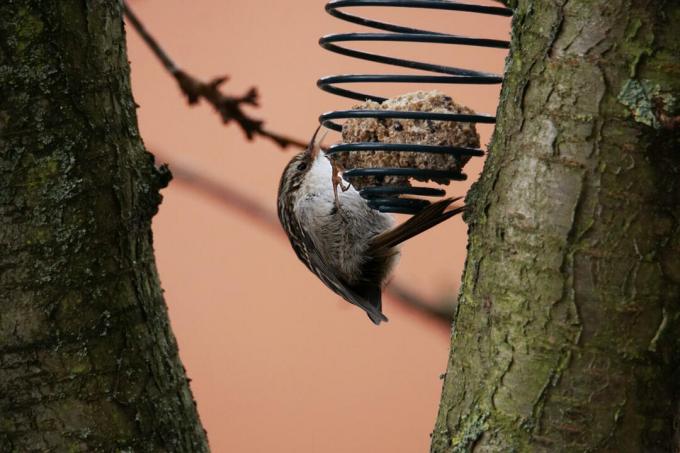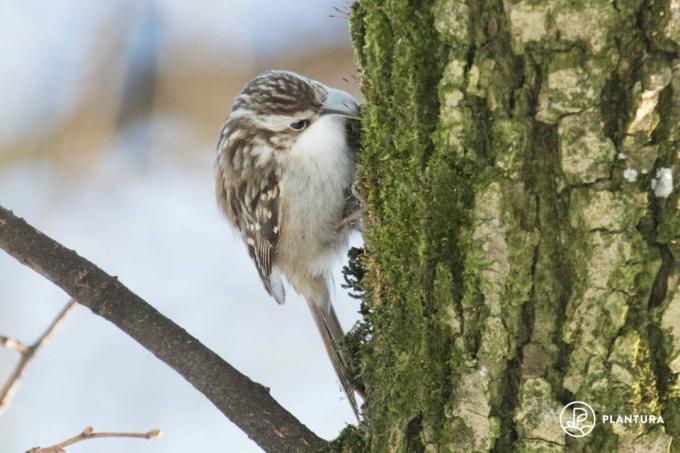What are the differences between the short-toed treecreeper and the short-toed treecreeper? What does the treecreeper look like and how do you recognize a treecreeper nest? We answer these and other questions in our profile.

The treecreeper (Certhia brachydactyla) is a rather inconspicuous visitor. Its brown patterned plumage camouflages it perfectly when perched in a tree, making it difficult to spot. However, when it goes in search of food, it scurries along tree trunks and branches with its jerky gait and can be easily observed. Treecreeper always walk upwards. When they get to the top of the tree, they fly to the next one, landing far down the trunk and continuing their hunt upwards. How to tell the nimble birds apart from their closest relatives, the treecreepers, even by their song recognize and how you can offer the short-toed treecreeper a home, you can find out here in our large Characteristics.
contents
- Short-toed treecreeper: profile
-
How to recognize the garden treecreeper
- What is the difference between the short-toed treecreeper and the short-toed treecreeper?
- What does the treecreeper song sound like?
- What do treecreeper eggs look like?
- Which habitat does the short-toed treecreeper prefer?
- Where does the short-toed treecreeper build its nest?
- When is the breeding season of the short-toed treecreeper?
- Where does the short-toed treecreeper spend the winter?
-
Support the short-toed treecreeper in the garden: Here's how
- What do treecreepers eat?
- Which nest boxes are suitable for short-toed treecreepers?
- How can you provide additional support for the treecreeper?
Short-toed treecreeper: profile
| size | Approximately 12-13cm |
| Weight | Approximately 11g |
| breeding season | April - July |
| lifespan | About 5 years |
| habitat | Old forests, parks and gardens with old trees |
| feed preference | insects, spiders and tree seeds |
| threats | decline in food and habitat |
How to recognize the garden treecreeper
Short-toed treecreepers are rather inconspicuous, small birds. Their plumage is patterned brown-grey on top, while the throat, chest, and belly are colored off-white. Its face is adorned with a faint, light-colored stripe above its eyes and a long, narrow, curved beak. The short-toed treecreeper uses their long brown tail to support themselves when they move vertically up a tree trunk.
Male and female short-toed treecreepers cannot be distinguished visually. And the young birds look so similar to their parents that you cannot clearly separate them from them.

What is the difference between the short-toed treecreeper and the short-toed treecreeper?
Short-toed treecreepers are confusingly similar to their closest relatives, the treecreeper. While there are certain characteristics by which species can be distinguished, these vary from individual to individual and are therefore not always clear. One of these features is the narrow, pointed beak, which is significantly longer in the garden treecreeper than in the treecreeper. However, the treecreeper has a longer hind toe and usually a lighter belly. Experts also find differences in the wing pattern, but these can only be seen if you look very closely.
Notice: Garden and treecreepers are best distinguished not by their appearance but by their song.

What does the treecreeper song sound like?
The song of the treecreeper consists of a stanza of high, fine whistles, which form a small trill in the middle: "Tüütetitü-tü-tititit". In addition to this distinctive song, the treecreeper also has a few calls that sound just as high and fine and consist of individual, clear whistles.
The song of the treecreeper sounds like this:
What do treecreeper eggs look like?
The eggs of the treecreeper are about 1.5 centimeters in size, have a whitish base color and are decorated with fine reddish-brown speckles. A clutch usually consists of four to six eggs, which are laid in a nest made of brushwood, moss or blades of grass. The nest cavity is additionally lined with fine feathers and animal hair.
Which habitat does the short-toed treecreeper prefer?
The short-toed treecreeper loves big, old trees. It can therefore be found in deciduous forests or meadow orchards, but also in large parks or gardens with old trees. Other possible habitats are avenues, cemeteries or semi-open landscapes with smaller or larger groups of trees.

Where does the short-toed treecreeper build its nest?
Short-toed treecreepers build a cup-shaped nest from a wide variety of materials. The nest is built in tree cracks, wall crevices or building niches, often hidden behind protruding bark. Both breeding partners take care of nest building in the garden treecreeper.
When is the breeding season of the short-toed treecreeper?
The breeding season of the short-toed treecreeper begins in April when the first eggs are laid. These are incubated for about two weeks. The young birds then hatch and are fed around the clock by both parents for a further 14 days. After the little treecreepers have left the nest, they are cared for by their parents for only a few weeks before they are completely on their own.
Where does the short-toed treecreeper spend the winter?
are garden creepers sedentary birds, which spend the whole year in their breeding areas. They therefore do not fly south, but stay with us during the cold winter months. Although the little treecreepers are actually loners, they form smaller groups of up to 20 animals in particularly cold times, which warm each other up in suitable shelters.

Support the short-toed treecreeper in the garden: Here's how
As the name suggests, short-toed treecreepers can also be observed in domestic gardens. Here you can find out how you can offer the climbing artist an inviting home.
What do treecreepers eat?
Short-toed treecreepers change their diet depending on the season. In the summer and during the breeding season, they mainly eat insects and other small animals, which they collect between crevices in the bark. They also use fine tree seeds in winter, when the insect supply decreases.

If you want to offer a feeding station in the garden in winter, you can also observe one or the other treecreeper there. Especially on fatty food or fat balls, the little birds like to help themselves. Our Plantura fat balls are therefore ideal for the little treecreeper. These consist of pure insect fat as well as high-quality seeds, berries and nuts and are therefore natural and rich food for many garden birds.

Plantura fat balls
Sustainable fat balls without a net,
Species-appropriate wild bird food with insect fat for year-round feeding
Notice: Since treecreepers usually move directly along the trunk of trees, it makes sense to attach a small feeding station directly there.
Which nest boxes are suitable for short-toed treecreepers?
Anyone who wants to offer a nesting box for short-toed treecreepers should think a little more about make its construction, because the little climbers have special demands on their artificial nesting sites. The so-called treecreeper caves are basically similar to a semi-cave box, but are completely closed at the front and have a small slot entrance of about 7 cm in height at the back.
How can you provide additional support for the treecreeper?
Vegetable food and bird food is mainly interesting for the short-toed treecreeper in winter. If you want to support the little songbird in summer and during the breeding season, you can design a insect friendly garden create an abundance of food. Avoiding the use of chemical sprays prevents wild birds from being poisoned through the food chain.
In summer, all garden birds are also happy about the offer of a watering hole. A flat bowl or trivet can easily be turned into a bird bath or be converted into a bird bath. It is only important that the water point is cleaned regularly, otherwise bird diseases can spread at such collection points. This risk is particularly high on hot days, which is why water and feeding areas should ideally be cleaned daily during this time.
Another small bird that likes to hunt insects on trees and can be observed here all year round is, for example, the smallest European songbird: the Goldcrest.
...and receive concentrated plant knowledge and inspiration directly in your e-mail inbox every Sunday!



